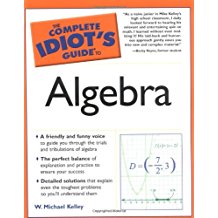Algebra: Dastardly Distribution
Dastardly Distribution
Many times you're going to see a number or variable multiplied by a quantity in parentheses, like this: 5(x + 1), which is read "5 times the quantity x plus 1." The parentheses are used to indicate that the 5 is multiplied by the entire quantity x + 1, not just the x nor just the 1.
According to an algebraic property (that I kept secret until now ¦ surprise!) called the distributive property, you can rewrite that expression as 5x + 5. In other words, you can multiply the 5 times everything inside those parentheses.
I think of the x and the 1 as my brother and I at Christmas time, and the 5 as a present from my grandmother. She knew that if she got us different presents, there would be strife in the house. Both of us would love our present but secretly covet the other guy's gift as well. To avoid this, my grandmother would give us both the same thing. That's how the distributive property works; it gives the same thing (in the form of multiplication) to everything in the parentheses to avoid conflict and, possibly, brawling beneath the mistletoe.
Talk the Talk
The distributive property is defined mathematically like this: a(b + c) = ab + ac. Notice that the a gets multiplied by the contents of the parentheses, which are then dropped; it works no matter how many items fall within the parentheses.
Critical Point
Occasionally, you'll see an expression like 2x - (3x - 5). Even though it's not written as such, this means the same as 2x - 1(3x - 5); the negative sign is actually an implied -1 coefficient. Therefore, to simplify the expression, you should distribute the -1 like this:
2x - 1(3x) - 1(-5)
= 2x - 3x + 5 = -x + 5
Example 5: Apply the distributive property: -2x(3x2 + 5y - 7).
Solution: Multiply everything in the parentheses by -2x, and add the results together:
- (-2x)(3x2) + (-2x)(5y) + (-2x)(-7)
Uh-oh ¦ how do you multiply -2x by 3x2? It's easyjust multiply the number parts together (-2 · 3 = -6) and the variable parts as well, using exponential rules (x · x2 = x1 + 2 = x3) to get -6x3. Do the same thing with the other two products as well.
Critical Point
I'll go into greater detail about how to multiply numbers and variables together in the begin-ning of Introducing Polynomials. If you're having trouble multiplying things together while using the distributive property, skip ahead and read the first couple of sections of Introducing Polynomials, and then return here.
- -6x3 - 10xy + 14x
Notice that there's no handy way to multiply x and y together in the second term; they aren't exponential expressions with the same base, so you can't add the powers or anythingjust leave them be and they won't hurt anyone, I promise.
You've Got Problems
Problem 5: Apply the distributive property: 6y3(2x - 5y2 + 8)

Excerpted from The Complete Idiot's Guide to Algebra © 2004 by W. Michael Kelley. All rights reserved including the right of reproduction in whole or in part in any form. Used by arrangement with Alpha Books, a member of Penguin Group (USA) Inc.
You can purchase this book at Amazon.com and Barnes & Noble.
